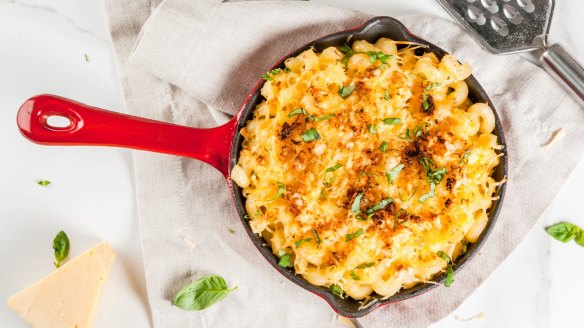The trick to reheating macaroni cheese

When I reheat my mac 'n' cheese, it splits and goes gluggy. L. Lee
While your mac and cheese was in the fridge, the pasta component was still absorbing liquid. This sneaky overnight operation left the macaroni plump and bloated and the sauce depleted of liquid, throwing the proportion of water to fat (from the cheese and butter used to make the sauce) out of whack. When you reheat leftover mac and cheese, there will be too much fat in the sauce and it will curdle. But add enough warm milk to make the sauce smooth and creamy and the ratio of fat to water will return to normal. I will also offer you a crisp alternative. Take a tablespoon of your cold mac and cheese in the palm of your hand, moistened with cold water, and form it into a squat cylinder. Roll in seasoned plain flour, bath in an egg and milk wash, and dredge in panko breadcrumbs. Then deep-fry in hot oil until golden brown. Remove, drain on paper towel, and season with salt. Enjoy your mac 'n' cheese croquettes with a cold beer.
Can I use sausages in sausage rolls? I. Maloney
You can make sausage rolls using sausages but choose low-fat snorkers. Sausages are packed with fat. The average sausage contains about 20 per cent fat, and some up to 30 per cent. If wrapped in pastry, that fat renders out and drenches the bottom of the pastry. The fat then heats up and fries the pastry. The same thing happens if you use fatty pork mince. For better results, remove sausages from their skins and mix through some extra herbs and perhaps some breadcrumbs soaked in milk, then squeezed to reduce the liquid content. This will make the mixture slightly less dense. You could also add a few tablespoons of tomato sauce. Mix well. Do not add salt. Sausages are already well seasoned. You can wrap a sausage in puff pastry, brush with egg wash, pop it into the oven preheated to 180C and cook it for 20-25 minutes and you will have something resembling the fast food you walk past at an agricultural show.
Letters
A few weeks back we were talking about asparagus. An avid reader B. Hooks wrote in with her suggestions on how to keep asparagus and other vegetables crisp and fresh. "As soon as I get these vegetables home," she writes, "I trim off the dried-out ends to unblock the capillaries, thus enabling them to take up water. Then I put them in a vase or container, with 25 mm of water in the bottom, freshly-cut-ends down, in the fridge. Veg stored like this last for ages and won't go limp because they keep taking up water." We also mentioned the planting of asparagus along the banks of the Murray River in the late 1800s. I said Australia's version of Johnny Appleseed was a woman, who I gave the moniker Asparagus Annie. Mildura local Stefano de Pieri, owner-chef at Stefano's Cantina, Stefano de Pieri, corrected me. It was actually Mildura's first physician, Dr Otto Abramowski, who planted asparagus along the Murray.
Send your vexing culinary conundrums to brainfood@richardcornish.com.au or tweet to @foodcornish
Appears in these collections
Restaurant reviews, news and the hottest openings served to your inbox.
Sign up- More:
- Restaurant news
